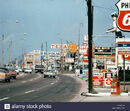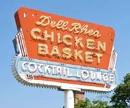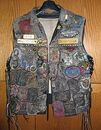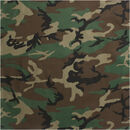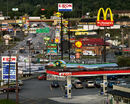Americana is a loosely-defined aesthetic which consists of music, artifacts, scenery, folklore, and material culture which are seen as distinctly or especially "American" (i.e., of or relating to what is now the United States and its inhabitants). There is considerable disagreement over what counts as "American" because vast differences exist between different regions and subcultures within American society. For example, most people would put Jazz or Hip-Hop aesthetics in separate categories from Americana, despite both genres being uniquely American in their origins, promulgation, and current praxis. Similarly, Juggalos and the Amish do not fall under the "Americana" umbrella, though Yeehaw might.
Much of the aesthetic is characterized by nostalgia for an idealized or imagined past, often seen as "more wholesome" than modern American tastes and mores. The aesthetic is often commercialized: restaurant chains such as Red Robin and Applebee's decorate their interior walls with a seemingly-random collection of mid-20th century artifacts and signage which is affectionately known as "Americana clutter".
Philosophy
Individualism is the belief that someones moral worth is determined by the persons political, ideological, and philosophical outlook. It's the opposite of communitarianism.
Freedom is a strongly tied conviction present throughout America but especially the south. America is known as the "Land of the Free" due to freedom of religion, speech, press, opportunity, etc. These motifs were founded in the early years of America when those were relatively unheard of, and thus are embedded in the country's DNA. Many Americans have confused "freedom of speech/press" with "freedom from consequences". This is concentrated especially in the South in regards to gun rights.
Hard Work is seen as the only way to achieve success. Rednecks may appear to be lazy and be looked down upon for this, but in reality it is generational poverty which affects their circumstances.
Local community provides a sense of security and stability. These people share the same family background, race, culture, religion, and values. This can lead to a limited worldview, but since many Rednecks do not leave their hometowns, it is seen as a nonissue.
Visual
General
Americans as a whole share a national identity, encounter the same media and have a knowledge of history that creates a general aesthetic that applies to the nation as a whole. While many Americans may not like the aesthetic or even dislike it for its romanticization of the country, they will mutually agree on its American-ness. Examples include:
- American cuisine and comfort food, such as hamburgers, Thanksgiving dinner, and apple pie
- Baseball and football
- Denim, a popular American fabric
- Historical paintings and imagery, such as the Declaration of Independence and portraits of Founding Fathers
- Imagery associated with the 4th of July, such as fireworks
- 1950s-1960s imagery, as this was the time America was a superpower and had national unity among its white male citizens
- Norman Rockwell illustrations and paintings
- Stars
Greasers
Greasers are a youth subculture that was popularized in the 1950s to 1960s by predominantly working class and lower class teenagers and young adults in the United States. The subculture remained prominent into the mid-1960s and was particularly embraced by certain ethnic groups in urban areas, particularly Italian- and Hispanic-Americans.
For more information, please visit the Greaser page.
Route 66
Route 66 was named after historic U.S. Route 66, the first interstate highway to connect the East and West Coasts of the United States, this aesthetic is centered on classic American car culture. Though it is primarily a visual aesthetic, it is often associated with classic rock 'n' roll tunes from the 1950s. American care enthusiasts may also be referred to as gearheads.
This subgenre of the Americana aesthetic often overlaps with Greaser and hot-rod culture (a.k.a. Kustom Kulture).
Okies
Okies are residents, native, or cultural descendants of Oklahoma. During the 1930s, Californians referred to migrant Midwestern farmworkers as "Okies", who were refugee farm families from the Southern Plains who migrated to California to escape the ruin of the Great Depression and the Dust Bowl.
In James Blish's Cities in Flight science fiction series, the term "Okie" was applied in a similar context to entire cities that, thanks to an anti-gravity device, take flight to the stars to escape an economic collapse on Earth. Working as a migrant labor force, these cities act as cultural pollinators, spreading technology and knowledge throughout the expanding human civilization. The later novels focus on the travels of New York City as one such Okie city, though there are many others.
Redneck

Rolling hills showing wheat farming
The Redneck or Hillbilly aesthetic is concentrated in the rural poor from Southeastern United States with a strong emphasis on traditional values and the simple life. Terms like White Trash, Cracker, and Hick are also associated with this aesthetic, however these terms (and Redneck) are considered derogatory. The term redneck originated from 1893, coming from the sunburn often seen on farmers. Because of the large amount of rural land and short, subdued winters, colonists naturally chose the southeast for farming. The large, rolling hills also gave way to animal farms and became one of the key images associated to the southern aesthetic.

Norman Rockwell's 1948 painting “The County Agricultural Agent"
An ever-present theme of redneckism is racism and the confederacy. The Confederacy (also called CSA; Confederate States of America) existed from February 8th 1861 - May 9th 1865, and contained North and South Carolina, Florida, Virginia, Mississippi, Alabama, Louisiana, Texas, Georgia, Arkansas, and Tennessee. America's foundation in slavery was especially concentrated in the CSA, and when America went into a Civil War over slavery abolition, the Confederacy fought for slavery. Slavery was based in racism and white supremacy.
Although Rednecks are associated with the South and the Confederacy, they should not be confused with the wealthy plantation owners of 19th century and Southern Belle culture. The name Cracker comes from the position of the overseer on plantations, whose job it was to crack the whip in order to force enslaved people to work faster. Although their poverty placed them at the bottom of the social ladder, their whiteness placed them above any Black person, enslaved or free. This mentality still exists in many deep south homes.
In 1861, Confederate Vice president Alexander H. Stephens described the CSA as "upon the great truth that the negro is not equal to the white man; that slavery, subordination to the superior race, is his natural and normal condition". Even though the Confederacy lost, it is theorized that this false idea of racial superiority is one of the reasons appeal of the Confederacy remains strong.
American Dream
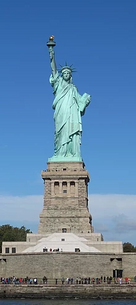
The Statue of Liberty
American writer and historian James Truslow Adams described the American Dream in 1931 as "life should be better and richer and fuller for everyone, with opportunity for each according to ability or achievement [or economic situation]". This idea is from the Declaration of Independence, which professes that all men are created equal.
The "American Dream" has changed over the decades and centuries.
Frontierism
In the 1700s the first American ideal was frontierism. Also called expansionism was the expansion of American territories into official, U.S. States. This was an age of mass migration and settlements with an attitude called "Manifest Destiny". Many Europeans were enticed by free land, and immigrated over to the States. This combination of many European cultures made America a "melting pot" of culture. This is also linked to the Western and Prariecore aesthetic. For more information, see the American Pioneers page.
Imagery:
- Cowboys
- Deserts
- Covered wagons
- Tans, sage, mustard yellow, rose gold, lavender
- Log cabins
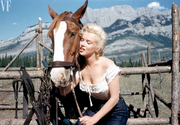
Marilyn Monroe in "River of No Return", which takes place during the gold rush and the current American Dream
Gold Rush
The discovery of Californian gold in 1849 brought about a whole new American Dream, although it still was influenced by frontierism. This is also linked to the Western aesthetic.
Suburbia
The post World War Two era brought about a new era of consumerism and national pride. Women were forced back into traditional roles as homemakers, while men became the main breadwinners. Technological advances such as washing machines, blenders, electric toasters, and televisions modernized the lives of the expanding middle class. Due to the Baby Boom, child and family friendly restaurants, hotels, and theme parks like Disneyland, enjoyed huge success. The term "teenager" was also used for the first time in the 1950s.
Despite the squeaky clean image, there was a dark side. Fears of Communism and homosexuality ran rampant. Many adults, especially women, become alcoholics and drug addicts after failing to shape their lives to fit society's expectations.
Women's fashion and gender expectations from this time period heavily influenced the Tradwife movement.
Imagery:
- white picket fences
- women wearing aprons over fancy dresses with high heels and pearl necklaces
- children playing baseball
- fast food like hamburgers, milkshakes, and hot dogs
- 1950s era cars
Music
Biker
- Tres hombres - ZZ Top (1973)
- Motörhead - Motörhead (1977)
- Lust For Life - Iggy Pop (1977)
- Sonic Brew - Black Label Society (1999)
Greasers
Route 66
- "Life is a Highway", by Rascal Flatts
- "Shake, Rattle and Roll", by Big Joe Turner
- Elvis Presley (early works)
- Chuck Berry
- Bill Haley & His Comets (esp. "Rock Around the Clock" and "Shake, Rattle and Roll")
- Jerry Lee Lewis
- Johnny Cash (early works)
- "On the Road Again", by Willie Nelson
- Hotel California - Eagles
- Take it Easy - Eagles
Okies
- California Okie – Buck Owens (1976).
- Dear Okie – Doye O’Dell/Rudy Sooter (1948)
- Lonesome Okie Goin’ Home – Merl Lindsay and the Oklahoma Night Riders (1947).
- Oakie Boogie – Jack Guthrie and His Oklahomans (1947) – considered by many to be the first Rock & Roll song.
- Okie – J. J. Cale (1974).
- "Okie From Muskogee" – a song by Merle Haggard from the 1969 album of the same name
- "Okie" – a song by Patrick Sky a parody of the above, from his 1973 album Songs that made America Famous
- Oklahoma Swing - by Reba McEntire and Vince Gill
- Okie Skies – The Bays Brothers (2004).
- Okies in California – Doye O'Odell (1949).
- Ramblin' Okie – Terry Fell.
- She's An Okie – Al Vaughn.
- Okanagan Okie – Stompin' Tom Connors
- "Israelites & Okies" a song from The Lost Dogs (Album Old Angel – Terry Taylor (2010 Fools of the World)
Redneck
- At Fillmore East - The Allman Brothers Band (1971)
- Second Helping - Lynyrd Skynyrd (1974)
- Molly Hatchet - Molly Hatchet (1978)
- Strikes - Blackfoot (1979)
- Blind melon - Blind Melon (1992)
Fashion
Biker
- Real leather jackets (moto jackets), vests
- Items are often custom embroidered to signify personal values and loyalties
- T-shirts, tank tops
- Bejeweled items are common depending on where the gang is located, especially for women.
- Heavy leather boots
- Riding gloves, helmets
- Hoodies/jackets/warm clothes for cold rides
- Studs, bandanas, chains
- Protective gear
Greasers
- Black Leather jackets
- Pompadours
- Jeans (do not wear while riding bikes)
- White T-Shirts
- Cigarettes
Okies
Under Construction
Redneck
- Flannel
- Heavy duty workwear
- T-shirts, tank tops
- Cut-off sleeves are typical
- Trucker hats
- Cowboy boots
- Timberlands
- Blue jeans, jean shorts
- Camouflage, neon orange/pink
- American flag print, Confederate flag print
Route 66
Under Construction
Media
Movies:
- On the Waterfront (1954)
- Rebel without a Cause (1955)
- Giant (1956)
- The Last Picture Show (1971)
- Paris, Texas (1984)
- Goodfellas (1990)
- O Brother Where Art Thou (2001)
- American Honey (2016)
- The Irishman (2019)
TV Shows:
- I Love Lucy (1951-1957)
- Leave it to Beaver (1957-1963)
- Mad Men (2007-2015)
- Wandavision (2021)


